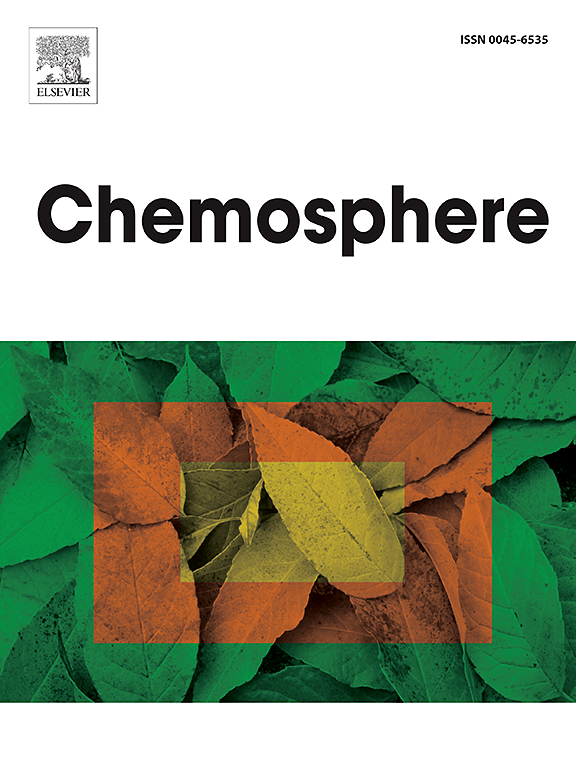无机砷的毒理学评价:石棘草的生物蓄积和免疫毒性
IF 8.1
2区 环境科学与生态学
Q1 ENVIRONMENTAL SCIENCES
引用次数: 0
摘要
海洋环境中的无机砷污染会对水生动物产生不利影响。本研究通过分析三价砷(III)和五价砷(V)对schlegel棘虫的组织生物蓄积和非特异性免疫反应,研究了其毒性。鱼在饲料中暴露于0、5、10和15 mg kg - 1的砷(III)或砷(V) 28 d。暴露结束时,总砷(TAs)积累量(mg kg - 1湿重)在肝脏中最高(4.26-8.87),其次是肌肉(2.13-2.88)、肠道(0.97-2.02)和血液(0.30-0.89)。在接触期间,在肝脏(0.05-0.06)、血液(0.07-0.16)和肠道(0.05-0.36)中检测到无机砷,而在肌肉中未观察到积累。在所有组织中,砷甜菜碱(AsB)的积累略低于TAs。砷在所有组织中的生物积累与无机砷暴露水平不成正比,因为as (III)和as (V)都能迅速生物转化为毒性较小的AsB,表明黑鳃鱼的砷代谢正常。此外,双向方差分析显示,所有砷物种的生物积累在组织之间和两种砷暴露形式之间存在显著差异。在免疫毒性方面,饮食中暴露于砷(III)和砷(V)可显著抑制白细胞的非特异性免疫反应,从第7天开始观察到吞噬率、吞噬指数和呼吸爆发活性显著降低。这些发现有助于加深对海洋鱼类中砷的生物积累和免疫毒性的认识,并为水产养殖饲料中砷污染的风险评估提供重要数据。本文章由计算机程序翻译,如有差异,请以英文原文为准。

Toxicological assessment of inorganic arsenic: Bioaccumulation and immunotoxicity in Acanthopagrus schlegelii
Inorganic arsenic contamination in the marine environment can have adverse effects on aquatic animals. This study investigated the toxicity of trivalent As (III) and pentavalent As (V) in Acanthopagrus schlegelii by analyzing tissue bioaccumulation and non-specific immune responses. Fish were exposed to dietary As (III) or As (V) at 0, 5, 10, and 15 mg kg−1 for 28 d. The total arsenic (TAs) accumulation (mg kg−1 wet weight) was highest in the liver (4.26–8.87), followed by the muscle (2.13–2.88), intestine (0.97–2.02), and blood (0.30–0.89) at the end of exposure. During the exposure, inorganic arsenic was detected in the liver (0.05–0.06), blood (0.07–0.16) and intestine (0.05–0.36), whereas no accumulation was observed in muscle. The accumulation of arsenobetaine (AsB) was slightly lower than that of TAs across all tissues. Arsenic bioaccumulation in all tissues was not directly proportional to the levels of inorganic arsenic exposure, as both As (III) and As (V) were rapidly biotransformed into less toxic AsB, indicating normal arsenic metabolism in black seabream. Moreover, a two-way MANOVA analysis revealed that the bioaccumulation of all arsenic species differed significantly among tissues and between two arsenic exposure forms. In terms of immunotoxicity, dietary exposure to As (III) and As (V) significantly suppressed nonspecific immune responses in leukocytes, with marked reductions in phagocytic rate, phagocytic index, and respiratory burst activity observed from 7 d onward. These findings enhance the understanding of arsenic bioaccumulation and immunotoxicity in marine fish and provide important data for the risk assessment of arsenic contamination in aquaculture feeds.
求助全文
通过发布文献求助,成功后即可免费获取论文全文。
去求助
来源期刊

Chemosphere
环境科学-环境科学
CiteScore
15.80
自引率
8.00%
发文量
4975
审稿时长
3.4 months
期刊介绍:
Chemosphere, being an international multidisciplinary journal, is dedicated to publishing original communications and review articles on chemicals in the environment. The scope covers a wide range of topics, including the identification, quantification, behavior, fate, toxicology, treatment, and remediation of chemicals in the bio-, hydro-, litho-, and atmosphere, ensuring the broad dissemination of research in this field.
 求助内容:
求助内容: 应助结果提醒方式:
应助结果提醒方式:


